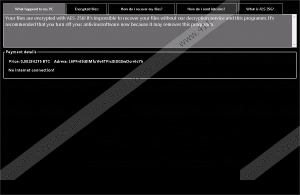Null Ransomware Removal Guide
Null Ransomware is the name of a new dangerous threat that can cost you your personal files, as it encrypts them all after managing to sneak onto your system without your noticing it. If you do not have a recent backup stored on a portable hard disk or in cloud storage, it is quite likely that you are going to lose all your photos, videos, documents, and archives in one go. Of course, you are offered to recover your files by transferring the ransom fee to your attackers, we do not advise you to comply with this demand. In fact, it is always risky to even contact cyber criminals, let alone to send money to them. What do you think can stop them from attacking you again knowing that you are willing to pay? On the other hand, why would you support cyber criminals to commit more crimes? Still, this is your decision to make, of course. But experience shows that crooks rarely keep their word. We recommend that you remove Null Ransomware as soon as possible even if it may mean that you will not be able to recover your files. We cannot confirm it but there is a chance that malware experts will come up with a free tool in the near future that could help you decrypt your files, so it may be a good idea to keep the encrypted files even though they are useless and inaccessible at the moment.
It is quite likely that you have opened a spam e-mail that had a malicious attachment posing as an image or a document. This is how most of the victims actually get infected with ransomware in general. But this spam is not what it used to be. Years ago it was quite obvious that you were dealing with a spam as these mails used fake e-mail addresses and senders as well as the subject and the message had telltale signs. However, nowadays cyber crooks tend to lure you with authentic-looking senders and subject lines that may draw your attention right away. Nobody would be likely to ignore a mail coming from the local authorities claiming that you have not paid a speeding ticket or that your bank has noticed illegal money movements on your account. And, criminals know this and use it to deceive unsuspecting users. Most of the time it is not the worst move that you open the mail, although sometimes even that can trigger the drop of such a dangerous infection. In this case though, you need to save and run the attached file to initiate this attack. This fact should also make it clear that you cannot delete Null Ransomware without consequences.
This ransomware drops its own .exe file to %APPDATA% with a random name after you launch it. Then, it targets your most precious personal files, such as your photos, document, and archives, and encrypts them using the AES-256 algorithm, which is, in fact, a built-in Windows function. That is why it can finish practically in no time at all depending on the number of affected files and the performance of your PC. All the encrypted files get a ".null" extension, which signals the extent of the damage done if you search for this extension in your File Explorer.
Then, this vicious program displays its application window, a huge black window that contains the ransom note and all the information you need to be able to recover your files. It seems that the amount of the ransom fee could be different for every user and might be based on the number of files encrypted because our research has come up with extreme difference in price. We have found that this ransomware may ask for as little as 10 US dollars worth of Bitcoins and as insane as 10,000 dollars worth. No matter the price though, we do not advise you to pay even if that means losing your files. Hopefully, you are a security-minded user who makes regular backups, which you can use now after you remove Null Ransomware from your system. So let us see how you can eliminate this dangerous threat.
First of all, you need to kill this malicious process by opening your Task Manager and identifying this random-name process. Then, you can delete all related files from your computer. Please follow our guide below if you want to tackle this severe threat on your own. However, if you would like to defend your PC against all kinds of malicious attacks automatically, you should consider purchasing a decent anti-malware program like SpyHunter. Remember that you can also protect your PC if you stay away from suspicious websites, e-mails, and clicking on third-party ads. Also, it is vital that you update your programs frequently to keep cyber criminals away from your system.
How to remove Null Ransomware from Windows
- Press Ctrl+Shift+Esc simultaneously to launch the Task Manager.
- Locate the random-name process and identify it by clicking on it with the right mouse button, and choosing Properties.
- If the Description field reads "Strix", you have found the malicious process.
- Click OK or press Esc to close the Properties pop-up.
- Remember the random name so that you can identify it later.
- Press End task to kill the malicious process.
- Exit the Task Manager.
- Press Win+E.
- Open your "%APPDATA%" folder.
- Locate and delete the random-name malicious .exe file.
- Locate the suspicious file you have downloaded recently and delete it.
- Empty your Recycle Bin.
- Reboot your PC.
Null Ransomware Screenshots:


